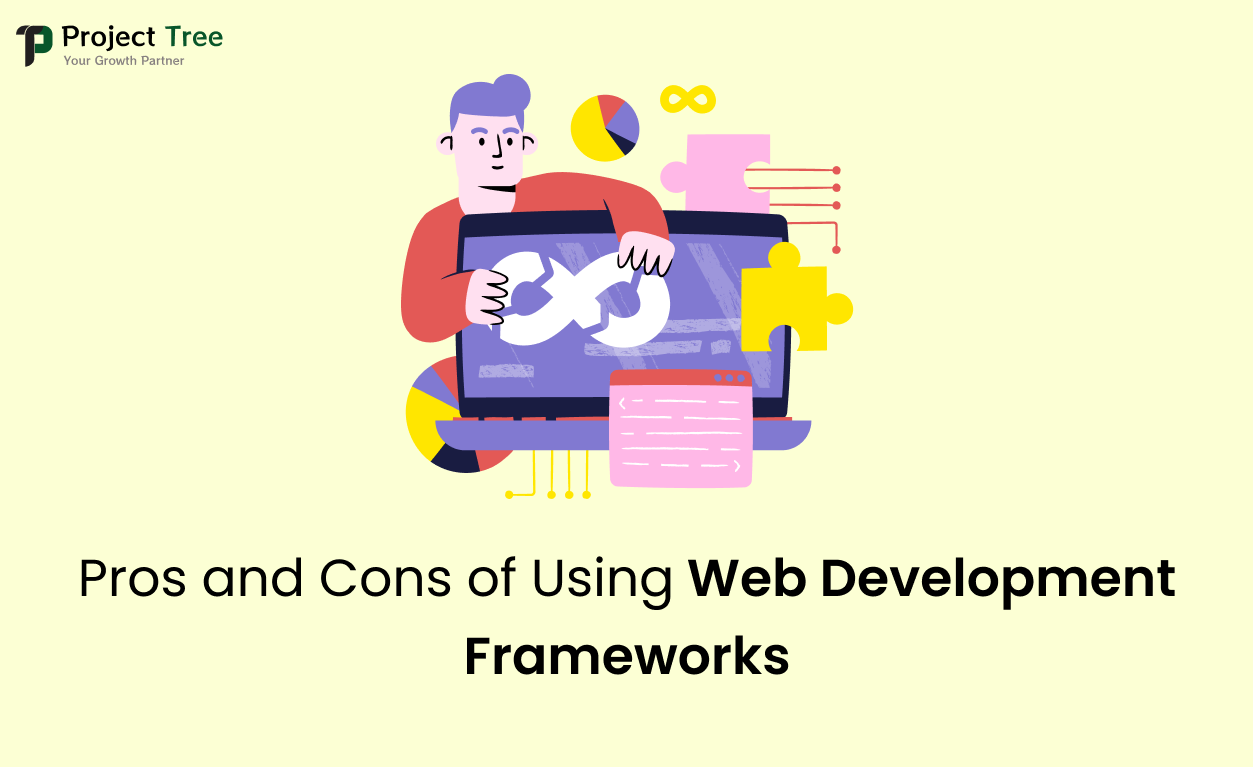Web development frameworks, which offer a structure framework for developing and overseeing applications for the web, are now essential tools in today’s web development process. The frameworks—React, Angular, and Django, for example—give developers access to a variety of assets, standards, and technologies to speed up the development cycle. Yet, they come with a unique set of advantages and disadvantages similar to any other type of technology. To help you decide if frameworks for web development were an ideal option for your endeavor, we’re going to discuss the advantages and disadvantages of using these tools in this post.
Pros of Using Web Development Frameworks
1. Accelerated Development Process
The speed at which web development platforms assist production is one of the primary advantages of using them. With pre-written software and tools that handle routine tasks, frames free allow programmers to focus on developing unique characteristics rather than creating them from scratch. Time spent on development may be significantly reduced by using frameworks like Django that have standard features for forms dealing with, managing databases, and security.
2. Consistent Code Structure
Software that is more readable and efficient can be developed by using frameworks that enforce standard codes and structures. Organizations work more successfully when there’s uniformity, and new programmers find it easier to understand and participate in the project. For instance, systems like Ruby on Rails’ Model-View-Controller (MVC) structure ensures an independent division of tasks, which helps code control.
3. Built-in Security Features
Web development needs security, and many frameworks have built-in security measures that help protect apps from attacks. For example, platforms such as Python and Laravel offer features that prevent CSRF (cross-site request forgery), SQL injections, and cross-site scripting (XSS). Developers might be allowed to avoid creating a zero in adding security measures due to these including safeguards.
4. Community Support and Resources
Popular web development frameworks have large and active communities, which could prove a valuable asset for developers. These communities involve an array of records, forums, and third-party extensions and plugins that may enhance the framework’s overall performance. For instance, the growing React ecosystem offers an array of tools, parts, and courses designed to simplify production and address typical issues.
5. Scalability
Many frameworks are scalability-focused, providing tools or patterns which make it simpler to build big and complex systems. For instance, building applications with just one page (SPAs) featuring intricate user interfaces and interactions is an excellent match with frameworks like Angular and Vue.js. Big applications can be simplified easier via these framework data finals, component-based construction, and management of state abilities.
6. Built-in Tools and Utilities
Frameworks often come with a suite of built-in tools and utilities that streamline common tasks. These tools may include code generators, testing frameworks, and debugging utilities. For example, frameworks like Angular and React provide development servers, hot-reloading features, and state management solutions. These tools enhance developer productivity and facilitate a smoother development process.
Cons of Using Web Development Frameworks
1. Learning Curve
Frameworks have a learning curve, yet they may speed up development. In order to use the structure efficiently, developers have to first give time to acquiring its rules, syntax, and tools. For beginners or people who are not used to the specific framework, the learning slope can pose an obstacle. For instance, beginners might find Angular’s large feature set and complex choices for configuration are a lot to navigate.
2. Performance Overhead
Some frameworks can introduce performance overhead due to their abstraction layers and built-in functionalities. This overhead can affect the speed and efficiency of the application, especially if the framework includes features that are not needed for the specific project. For instance, a framework with extensive features for handling real-time data may introduce unnecessary complexity and reduce performance in a simpler application.
3. Dependency Management
Frameworks often rely on various dependencies and third-party libraries, which can lead to issues with dependency management and version compatibility. Keeping track of updates, security patches, and potential conflicts between different libraries can be challenging. Additionally, if a framework or library becomes deprecated or unsupported, it can create maintenance challenges for the project.
4. Limited Flexibility

Frameworks come with predefined ways of doing things, which can limit flexibility in certain scenarios. Developers may find themselves constrained by the framework’s conventions and patterns, making it difficult to implement custom solutions or features that don’t fit within the framework’s structure. For example, a framework that enforces a specific routing mechanism may not accommodate unconventional routing requirements.
5. Overhead of Abstractions
Framework layers make a lot of the modern web development process easier, yet they can also hide deeper mechanisms and make it difficult for programmers to understand what is going on behind the scenes. The absence of transparency could render it harder to recognize and resolve problems as they develop. A system that hides away data connections, for example, may render it harder for developers to understand limits on performance or enhance inquiries.web
6. Potential for Bloat
Many frameworks offer an extensive range of functions and elements that might not be necessary for every project. Coding bloat constitutes a situation in which an application’s size grows and its efficiency may be affected by unused features and dependencies. Developers must be aware of which features they include and may need to perform more tasks to eliminate unnecessary features.
Conclusion
Web development frameworks offer a host of benefits, such as scaling, built-in safety features, more rapid growth, uniform code fashion, and support from the community. They have certain drawbacks, however, like a steep learning curve, speed overhead, difficulties with dependence leaders, a lack of adaptability, and abstraction costs.
When should one use a web development framework? Basically, the decision depends on the nature of your project or the requirements that you have for your project. Some of the key aspects that need to be taken into consideration include the size of the project, expertise of the development team, expected performance and if the application is expected to require future modifications. Through such considerations, it is therefore possible to make well-informed decisions for a given project in order to achieve the desired development goals.
At Project Tree, we collaborate with DrPro to create tailored healthcare solutions that optimize clinic operations and patient management
FAQs
Q1. What is a web development framework?
A software framework for web development is a pre-written codebase and provides a foundation to develop apps for the web. It includes rules, libraries, and technologies that enhance coding structure, accelerate growth, and maintain best practices.
Q2. What are some popular web development frameworks?
React and Angular are popular frameworks for front-end web development, while Django, Ruby on Rails, and Laravel are popular frameworks for back-end web development. Each structure provides benefits over all of them and performs best with specific types of applications.
Q3. How do I choose the right framework for my project?
The functions of the structure, the development team’s expertise, and the project’s needs all play a role in selecting the best framework. Before selecting the choice, take into consideration aspects like scalability, support from the community, simple learning, and efficiency needs.
Q4. Can I switch frameworks after starting a project?
Switching frameworks mid-project can be hard and could require major refactoring. While moving to a fresh structure is possible, it’s usually cheaper to pick the right one from the start to avoid problems and additional costs.
Q5. Are web development frameworks suitable for all types of projects?
Web development tools can be quite helpful for many projects, yet they may not be an ideal choice in every situation. It may be more suitable to implement custom solutions without a framework for relatively simple tasks or ones with really specific needs.

